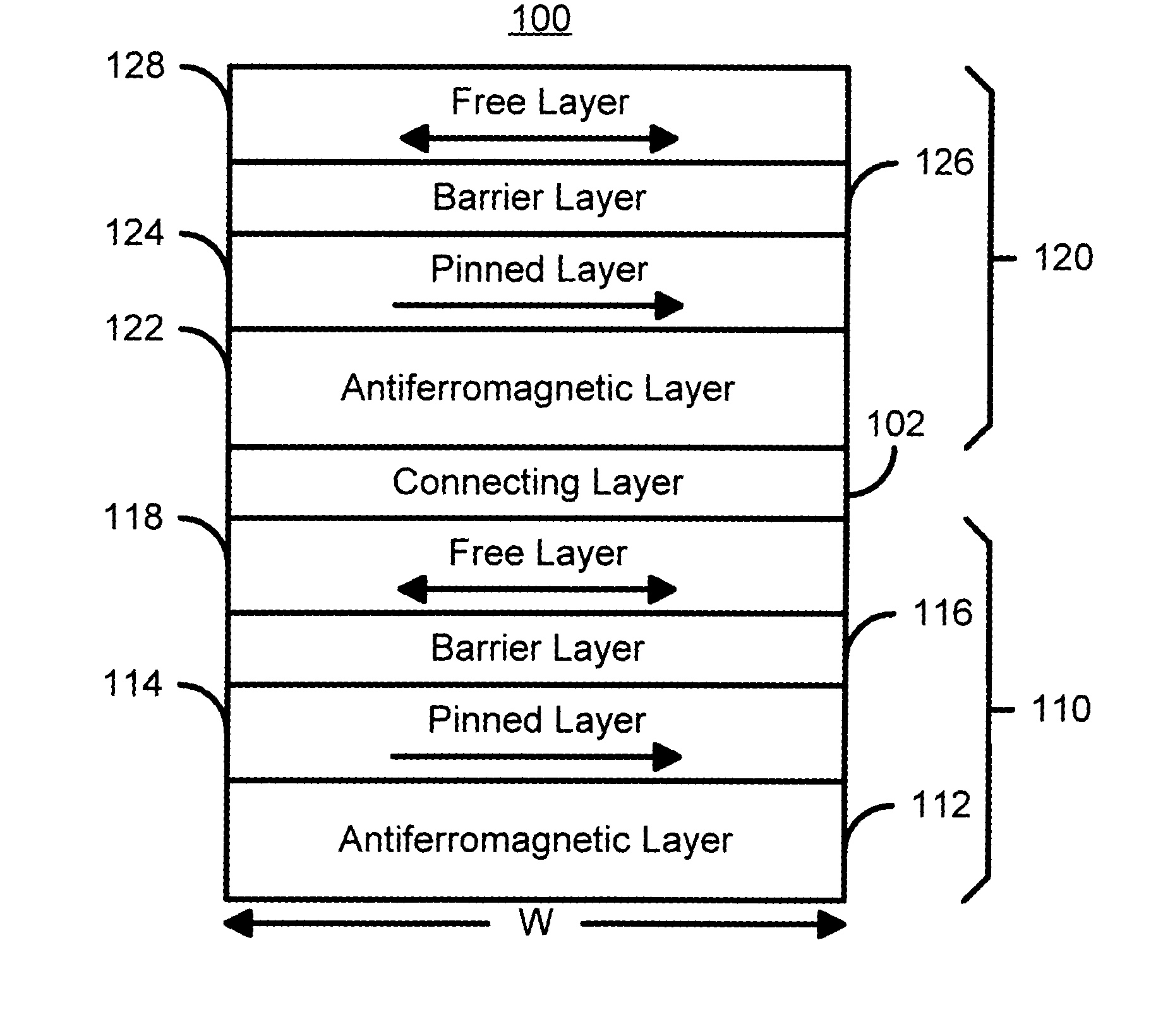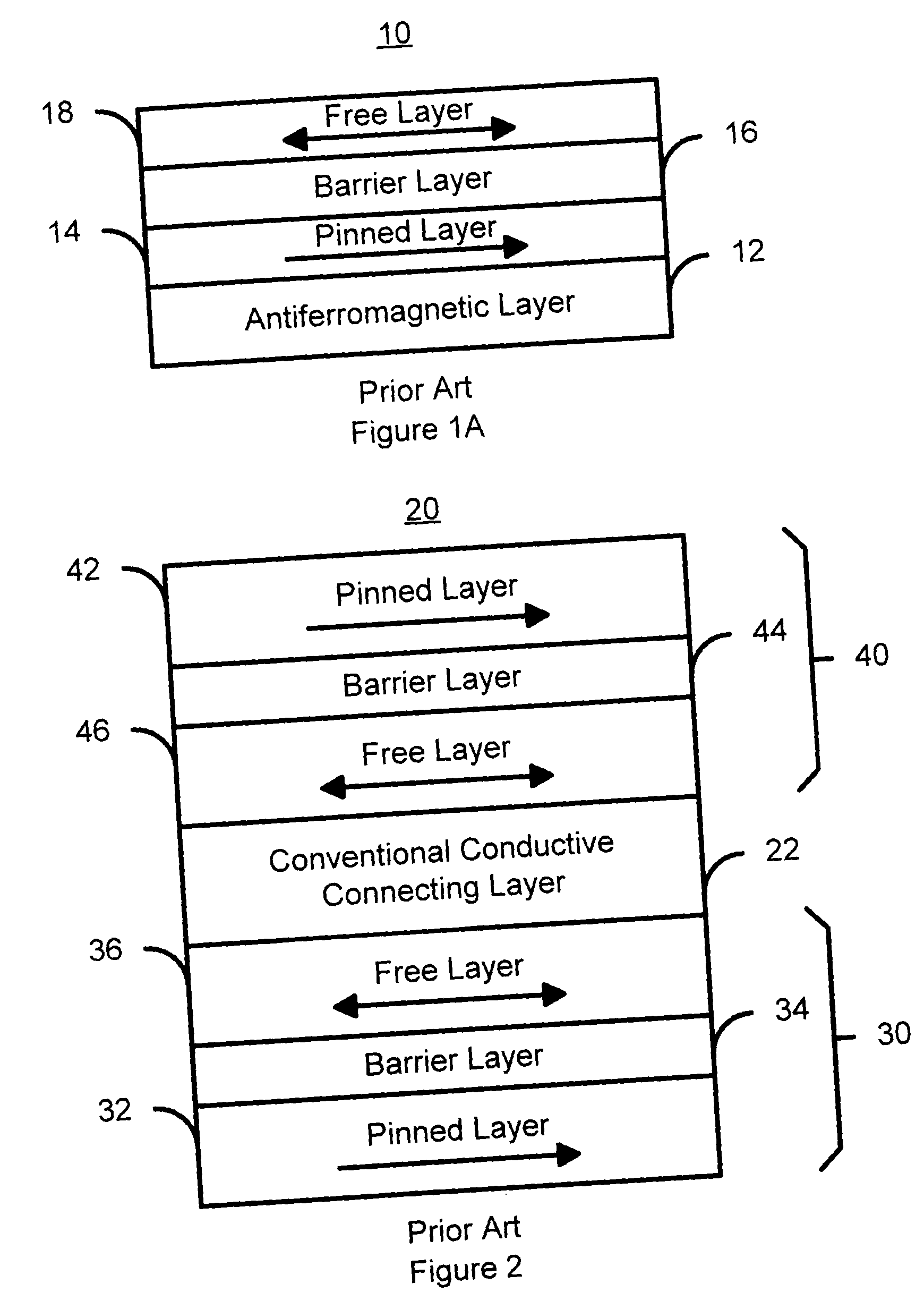Magnetic memory element utilizing spin transfer switching and storing multiple bits
a memory element and spin transfer technology, applied in the field of magnetic systems, can solve the problems of increasing the area and complexity of the stack, increasing the number of hosts, and increasing the number of cross-talk and power consumption, so as to reduce the height of the stack
- Summary
- Abstract
- Description
- Claims
- Application Information
AI Technical Summary
Benefits of technology
Problems solved by technology
Method used
Image
Examples
second embodiment
[0052]FIG. 4A is a diagram of a magnetic element 100′ in accordance with the present invention capable of storing multiple bits and utilizing the spin transfer phenomenon for writing. Many of the components of the magnetic element 100′ are analogous to those of the magnetic element 100 depicted in FIG. 3A. Consequently, these components are labeled similarly. For example, the magnetic element 100′ includes spin tunneling junctions 110′ and 120′. However, the connecting layer 102 has been replaced by shared AFM layer 102′. In addition, the AFM layers 112 and 122 have been omitted. Instead, the single shared AFM layer 102′ functions as both a connecting layer (similar to the connecting layer 102) and a layer used to pin the magnetizations of the pinned layers 114′ and 124′ (similar to the AFM layers 102 and 112). Alternatively, to further reduce stack's height, the pinned layers 114′ and 124′ and pinning AFM layer 102′ can be replaced by an antiferromagnetically coupled hard magnetic ...
third embodiment
[0054]FIG. 5A is a diagram of a magnetic element 200 in accordance with the present invention capable of storing multiple bits, utilizing the spin transfer phenomenon for writing, and utilizing a dual spin tunnel / valve structure. The magnetic element 200 thus includes dual spin tunnel / valve structures 210 and 230 separated by a connecting layer 202. The dual spin tunnel / valve structure 210 includes a pinned layer 214, a nonmagnetic layer 216, a free layer 218, a barrier layer 220, and a pinned layer 222. The dual spin tunnel / valve structure 210 also preferably includes AFM layers 212 and 224 used to pin the magnetizations of the pinned layers 214 and 222, respectively. The dual spin tunnel / valve structure 230 includes a pinned layer 234, a nonmagnetic layer 236, a free layer 238, a barrier layer 240, and a pinned layer 242. The dual spin tunnel / valve structure 230 also preferably includes AFM layers 232 and 244 used to pin the magnetizations of the pinned layers 234 and 242, respect...
fourth embodiment
[0060]FIG. 5B is a diagram of a magnetic element 200′ in accordance with the present invention capable of storing multiple bits, utilizing the spin transfer phenomenon for writing, and utilizing a dual spin tunnel / valve structure. The magnetic element 200′ is analogous to the magnetic element 200. Consequently, many of the components are labeled similarly. However, the positions of the nonmagnetic spacer layers 236′ and 216′ and barrier layers 220′ and 240′, respectively, have been reversed. However, the magnetic element 200′ functions in substantially the same manner as the magnetic element 200. Consequently, the dual spin tunnel / valve structure 210′ and 230′ can be written by driving a current through the magnetic element 200′ and exploiting spin transfer as described above. Thus, the magnetic element 200′ has many of the same advantages as the magnetic element 200.
PUM
| Property | Measurement | Unit |
|---|---|---|
| depth | aaaaa | aaaaa |
| thickness | aaaaa | aaaaa |
| current | aaaaa | aaaaa |
Abstract
Description
Claims
Application Information
 Login to View More
Login to View More - R&D
- Intellectual Property
- Life Sciences
- Materials
- Tech Scout
- Unparalleled Data Quality
- Higher Quality Content
- 60% Fewer Hallucinations
Browse by: Latest US Patents, China's latest patents, Technical Efficacy Thesaurus, Application Domain, Technology Topic, Popular Technical Reports.
© 2025 PatSnap. All rights reserved.Legal|Privacy policy|Modern Slavery Act Transparency Statement|Sitemap|About US| Contact US: help@patsnap.com



